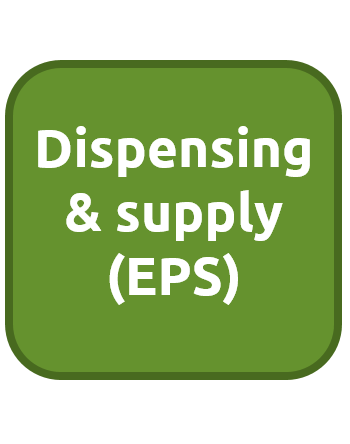Electronic Repeat Dispensing (eRD)
Published on: 16th July 2013 | Updated on: 15th March 2022
Release 2 of the Electronic Prescription Service (EPS) includes electronic repeat dispensing (eRD) service.
How does eRD work?
- Multiple ‘issues’: When issuing a repeatable prescription, the prescriber will authorise a prescription with a specified number of issues; each issue contains the same prescribed items.
- Issues are retrieved one-by-one: The Spine then manages the release of each individual prescription issue. The first issue of the prescription is available as soon as the prescription is received by the Spine; subsequent issues will be created on the Spine ready to be pulled down later.
- A new repeatable prescription requested for after the last issue: Once all authorised issues of the prescription have been dispensed, or if the prescription has expired, the repeatable prescription is complete and the patient must contact his GP to arrange for another repeatable prescription to be issued. Pharmacists should advise patients of the need to contact their prescriber when dispensing the last issue of a repeatable prescription.
- Automated process for allowing time to prepare medicine for each issue: To allow pharmacists to prepare medicines for dispensing in advance of a patient visiting the pharmacy, the Spine will automatically send the nominated dispensing site a repeat dispensing prescription seven days before the expected end date of the previous issue of the prescription. The Spine should calculate the expected date of supply in association with the prescriber’s originally intended date.
- The workaround for the automated process (e.g. patient going on holiday): It is possible for a pharmacy to pull down issues in advance of them being sent automatically from the Spine, for example where the instalment dispensing interval is flexible and the pharmacist believes that an instalment should be dispensed at an earlier time because the patient is going on holiday. Pharmacy systems suppliers also have flexibility to implement more advanced scheduling functionality in their systems to support work flow in pharmacies.
- Ability to change nomination between issues: A repeatable prescription can only be issued electronically where it is being sent to a patient’s nominated pharmacy. Patients can choose to change their nominated pharmacy before the expiry of the repeatable prescription. In this case, all outstanding issues which have not been downloaded will be transferred to the new nominated pharmacy. This is different from the paper based repeat dispensing system where all issues must be obtained from the same pharmacy.
- Repeatable Prescription Authorising Token: When issuing an electronic repeatable prescription, prescribers can issue one of these.
Although there has been low uptake of paper based repeat dispensing service, feedback received from GP groups suggests there is enthusiasm amongst GPs for adopting repeat dispensing under EPS. This has the potential to offer workload savings for GPs and GP practice staff and as Release 2 of the service also supports the cancellation of prescriptions not yet pulled down, they can be reassured that if the patient’s circumstances do change, they have improved arrangements to cancel and reissue a repeat prescription for a patient.
EPS repeat dispensing timing logic
Previously, the countdown to the next issue of a repeat prescription didn’t begin until a dispense notification had been issued. This could delay the automatic download of future repeat prescriptions from the Spine, resulting in items not being available for patients in time.
Since February 2016, a dispense notification must still be sent, but this will not delay the start of the automatic countdown to the next issue.
Details about the change were outlined in a news article on the topic.
Patient video
NHS Digital have produced a Video explaining to patients how repeat dispensing works.
eRD campaign
NHS Digital has developed a series of materials to boost the usage of electronic repeat dispensing (eRD) as part of a newly launched awareness campaign.
The campaign, which aims to increase the use of eRD, will run from November 2016 with media activity until March 2017.
Community Pharmacy England is encouraging pharmacy teams to support the NHS Digital campaign and to make use of the resources which include:
- webinars – interactive, live sessions with the option to watch on-demand for GP practices and pharmacy teams;
- eRD e-learning – targeted at GP practice staff and pharmacy teams;
- an online toolkit containing guides, a patient leaflet, template PowerPoint presentation, and briefing – for use by GP practices, pharmacy teams, Local Pharmaceutical Committees and Clinical Commissioning Groups;
- regionally based training/awareness sessions – for GP practices and pharmacy teams; and
- a social media campaign – use #eRD to get involved.
NHS Digital is planning two more campaigns in 2017; one in spring to promote eRD for summer ailment treatments and another one in late summer with a focus on relieving winter pressures.
Commenting on the campaign, Alastair Buxton, Director of NHS Services, Community Pharmacy England said:
“eRD obviously brings benefits to patients and GP practice, but pharmacy contractors have also found it improves efficiency within the dispensary. As contractors look for additional operational efficiencies in advance of the funding cuts which have been imposed by the Department of Health, they may want to consider using the campaign materials to encourage patients and GPs to adopt widespread use of eRD.”
| Top tip | Summary | Advice |
| Repeat Dispensing | Encouraging GPs to use repeat dispensing may lead to benefits for pharmacies and GPs. |
Awareness of benefits: There can be a low awareness of the benefits of repeat dispensing amongst GPs and in one case, patients not being identified for repeat dispensing as GPs tended only to see acute patients who were not suitable for repeat dispensing. GP surgery processes to identify patients: Lessons learned include the need to encourage uptake of repeat dispensing and put in place appropriate processes in GP Practices to identify patients, for example practice nurses involved in the management of patients with long term conditions may be best placed to support patient sign-up. |
Q. The prescriber has not identified a dispensing interval on the prescription and the patient has told me that they are going on holiday for 6 weeks. Can I dispense 2 issues at the same time for the patient?
Yes, where a prescriber has not indicated the interval, the pharmacist should use his professional judgement to dispense instalments at an appropriate interval. From a process perspective, the issues must be pulled down and dispensed in order, so the pharmacy would be required to pull down the first issue, update the Spine to indicate that the issue had been dispensed and then repeat the process with the second issue. When processing electronic repeatable prescriptions, the pharmacy system will record the Prescription ID to facilitate requesting subsequent issues of the prescription.
To further improve the efficiency of processing repeat dispensing prescriptions, Community Pharmacy England would like to see a change to the model to allow multiple issues to be pulled down and prepared at the same time without the Spine having to be updated before the next issue can be retrieved.
Q. Are Repeat Authorisation (RA) forms required for electronic repeat prescriptions in the same way that they are for paper repeat prescriptions?
There is not an EPS ‘RA form’, but the patient may present the ‘repeatable prescription authorising token’ (see next question) which is not required to be seen by the pharmacy.
Q. What is the ‘repeatable prescription authorising token’? Are pharmacy teams required to see it for EPS repeat dispensing?
It is a type of prescription token. Prescribers can provide the patient with this so the patient knows how many prescription batch issues have been authorised. Prescription tokens are printed on prescription form stationary by the prescriber to accompany the electronic prescriptions. For standard prescriptions these are occasionally printed at the patient request or to pass on clinical information. With electronic repeat dispensing, prescribers may pass a token to the patient.
Pharmacy teams are not required to see this repeat token to process repeat prescriptions, and where it is presented, there is no need to send it to the Pricing Authority – unless it has been used as an alternative to a dispensing token for one of the dispensing episodes to capture a patient signature.
Q. Why does paper repeat dispensing involve a paper (RA) form, whilst there is no (RA) form for electronic scripts?
With paper prescriptions the legal instruction on a pharmacy to dispense, comes from the hand-written signature. Paper repeat dispensing therefore involves a paper RA form being issued by the prescriber which includes the legal instruction to dispense against the paper RD forms.
Electronic prescriptions use electronic signatures and repeat dispensing is therefore simpler for electronic prescriptions. When issuing a repeatable prescription, the prescriber will electronically authorise a specified number of issues and the patient’s nominated pharmacy can pull these down from the spine, as required.
A patient may present a ‘repeatable prescription authorising token’ (see question above).
Q. How is exemption information captured for electronic repeat dispensing?
As with standard electronic prescriptions, you must enter the correct payment/exempt category on the electronic prescription using the pharmacy system, to ensure reimbursement is correct.
In addition where a patient signature is required for electronic repeat prescriptions, this must be captured separately for each dispensing issue. If the patient pays for their prescription or is non-age exempt, the pharmacy can print a dispensing token to capture the patient signature. The only tokens required to be sent to the Pricing Authority are those relating to paid prescriptions and those used to collect the patient’s exemption declaration (for a reason other than age) will be required to be sent to NHS Prescription Services each month for audit purposes.
Electronic repeatable prescriptions are electronically authorised and sent to the patient’s nominated pharmacy so that they can pull them down from the spine, as required.
Q. Are patients required to consent to be issued with electronic repeatable prescriptions?
Patients must give informed consent to the sharing of information between the dispenser and prescriber before participating in the repeat dispensing service, both for the paper based and electronic repeat dispensing arrangements. Normally consent is obtained from patients by prescribers. A national leaflet (RD2) and consent form (RD1) have been produced by the Department of Health, the NHS England Area Teams are responsible for the distribution of these forms.
If a patient has already given his consent for the paper-based arrangements, there is no requirement to collect his consent again before issuing an electronic repeat dispensing prescription. If the patient has not already nominated a pharmacy, informed consent would be required before changing the patient’s nomination settings.
Community Pharmacy England Briefing 001/14:  Repeat Dispensing and EPS (January 2014)
Repeat Dispensing and EPS (January 2014)
This Community Pharmacy England Briefing provides pharmacy contractors and LPCs with a summary of information on repeat dispensing using the EPS system and the answers to frequently asked questions.
The following presentation can be used in discussions with GP practices in order to demonstrate the similarity of repeat prescribing and EPS repeat dispensing and the additional benefits of using repeat dispensing:
Comparison of repeat dispensing and repeat prescribing (PowerPoint)
Comparison of repeat dispensing and repeat prescribing (PDF)
NHS England published Electronic Repeat Dispensing – Guidance in June 2015. This document clearly describes how Electronic Repeat Dispensing works and is aimed at CCGs and GP practice teams. Pharmacy contractors may want to use the document in discussions with local GP practices about repeat dispensing.
 |
 |
 |
 |













